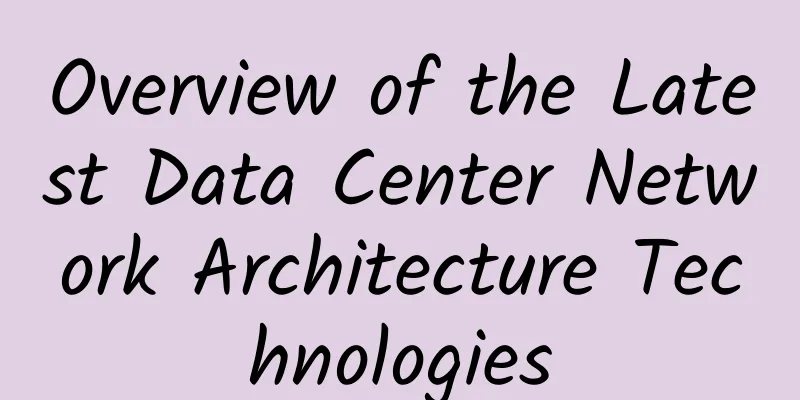Overview of the Latest Data Center Network Architecture Technologies

|
The network is the most important part of the data center. It is mainly composed of a large number of Layer 2 access devices and a small number of Layer 3 devices. In the past, the network scale of the data center was generally small, and the network could achieve the purpose of interconnection and interoperability by simply interconnecting dozens of devices. Now, the data center has higher and higher requirements for the network. In order to meet various applications, the network architecture also needs to be adjusted in time, and the network architecture has undergone various changes. In the process of building a data center, the network architecture is an important part. The quality of the architecture design directly determines the data forwarding efficiency and reliability of the data center. At the same time, if a network company can propose a more advanced network architecture and be recognized by the data center, it will naturally use the network equipment provided by the network company, thereby shielding competitors from the network architecture and obtaining the entire network or most of the network equipment share. Let's take a look at what new network architecture technologies have been recently introduced. Scale-free network model
The scale-free network theory is an important contribution made by Barabasi, an authority on complex networks, to Internet research. In network theory, scale-free networks refer to a type of network with specific characteristics. In this network, most nodes have very few edge connections, and only a very small number of nodes have a large number of edge connections. This small number of nodes with a large number of connections are called "key nodes" in the scale-free network model. Key nodes bear the connectivity of the entire network. If the connectivity of the entire network is used as an evaluation standard, and each node is given a weight to measure the contribution of the node to the connectivity of the network, then the weight ratio of key nodes to ordinary nodes must be very large. From this, we can conclude that in a scale-free network, the loss of one or even several ordinary nodes will have a minimal impact on the network, while the loss of a critical node with a very large weight may have a huge impact on the network. Different devices in the network have different weights. The greater the weight of the critical location, the greater the impact on the data center. Scale-free networks are very robust, but they are extremely vulnerable to coordinated attacks. The scale-free network architecture can be used to design a data center network, that is, to appropriately decentralize the connections and reduce the distribution of key nodes. At the same time, it cannot be over-dispersed, which will weaken the advantages of the "key nodes". The cellular discrete data center architecture is to discretize a traditional data center, but the degree of discretization is not enough to eliminate the robustness of the node, and it can greatly enhance its ability to cope with coordinated attacks, which is called "sub-discretization". The scale-free network architecture theory design can grasp the key points of the network, protect key nodes, and greatly improve network reliability. Unite Cloud In February 2017, Juniper Networks released its latest data center network architecture, Unite Cloud, a data center framework designed to simplify the creation and maintenance of hybrid and multi-cloud environments. Unite Cloud includes the latest version of Juniper's data center management tool Network Director 3.0, as well as new QFX5110 data center switches that support 10/40GbE access speeds and four 100G uplinks. Unite Cloud also provides access to the Contrail JumpStart service to help customers deploy the Contrail cloud platform or Contrail network software in their data centers, which is particularly suitable for deploying OpenStack clouds. Unite Cloud provides the necessary basic modules for data centers to manage public, private, hybrid and multi-cloud environments, build and manage cross-regional cloud environments, and implement open data center architectures securely and simply to meet changing needs. The key technologies of Unite Cloud are: support for EVPN and VXLAN; automatic network detection and distribution of configurations, freeing network administrators from tedious manual configuration work. ASAP Cisco has recently proposed its own new data center network architecture ASAP. The first letter "A" stands for Analyze. In the future, the life of enterprises will rely on data analysis to make intelligent decisions, help improve customer experience, increase production efficiency, and reduce costs; the second letter "S" stands for Simplify, which includes the simplification of infrastructure, hardware, and management; the third letter "A" stands for Automate, which emphasizes that automation must be dynamic automation; the fourth letter "P" stands for Protect, and everything is built on the basis of security. ASAP closely combines analysis, simplicity, automation, and protection with consistent strategies, and combines the industry's leading data center network, security, converged infrastructure, and software-defined solutions to achieve hybrid cloud. ASAP includes a series of data center network hardware and software products, covering all aspects of the network, and is a collection of network technologies. With Cisco's position in the field of network technology, the ASAP solution it provides has a strong guiding significance. Although there is no new concept, it has also come up with several new products, covering multiple network technology fields, covering a wide range, and focusing more on software capabilities, more like a software solution. Espresso At the 2017 Open Network Summit ONS, Google first showed the outside world its peer-to-peer edge architecture Espresso, which is a software-defined network SDN architecture. Espresso can improve the user experience in two ways. The first is that it can automatically select the best data center location based on real-time performance measurement, and then serve a specific user from this location, so that the best network access environment can be provided to each specific user. Similarly, with Espresso, it is possible to respond to failures and congestion in the network and on the public Internet in real time. The second aspect is to isolate the logic and control of traffic from a single hardware router. A single distributed system aggregates network information and makes routing decisions instead of relying on thousands of routers to manage packet flows. The Espresso network architecture is fresh enough that Google itself is constantly researching and exploring it. Espresso can improve the speed of Google services for users through third-party network service providers. As the saying goes, "third-rate companies sell products, second-rate companies sell solutions, and first-rate companies sell standards." This is why there are so many network architecture solutions emerging today. Everyone wants to become a first-rate company in the future data center market. To do this, you need to have advanced technical concepts. If you just sell network products, it will be a low standard. Although data center customers will eventually buy network products, if you have advanced architecture concepts, you can develop exclusive solutions for customers, which can not only obtain higher overall profits, but also effectively shield competitors. Therefore, in many cases, data center customers need a package solution. Proposing your own advanced network architecture concept is conducive to attracting data center customers and winning market opportunities. In the fierce competition in the data center network market, it is important to publish your own network architecture, and more importantly, these architecture solutions can actually bring real benefits to data center customers, otherwise it will become a castle in the air. |
Recommend
Interviewer: What is your understanding of IO multiplexing?
"IO multiplexing" is a common technical...
The Internet of Things drives the rapid development of the chip industry
With the popularity of the Internet of Things (Io...
The main tasks of 5G in the 13th Five-Year Plan are determined
[[181279]] Recently, the Ministry of Science and ...
Visit the exhibition area without leaving home and experience Huawei's 5G technology beyond your imagination
[51CTO.com original article] Not long ago, Huawei...
The three major operators have invested 477.2 billion in 5G, unleashing the power of the digital economy engine
In fact, 2022 is another peak year for 5G investm...
my country's mobile internet traffic increased by 23.4% year-on-year during the Spring Festival holiday
Unlike in the past, affected by the epidemic, thi...
6G brings an innovative revolution, but also hides many crises and challenges
Although 6G will not be implemented until 2030, t...
12 principles to make data centers perform better
As American football star Tom Brady once said, &q...
Confirmed! Can you still access the 5G network without a 5G package? The deduction rules have been released
Expensive 5G plans After entering 2020, 5G has be...
Foxit Kunpeng OFD technology debuts at the 7th Military Expo to help the information construction of party, government and military documents
From July 5 to 7, 2021, the "9th China Comma...
Huawei Cloud Inclusive AI Open Day "Planting Grass" Record: Get Close to 2012 Lab + MVP, Two "Group Favorites"
[51CTO.com original article] Let me start with a ...
Gartner: Global 5G network infrastructure spending will nearly double in 2020
Recently, according to the forecast of Gartner, a...
Ruishu Information was once again selected as a cloud security example vendor in Gartner's "2022 China ICT Technology Maturity Curve Report"
In July 2022, Gartner, a global authoritative IT ...
How does 5G help enterprises explore the development of the Internet of Things?
What is the Internet of Things? The “internet of ...
5G R17 freeze time postponed for another half a year: What is the reason? What is the impact?
After two uncertain postponements, the 5G R17 fre...









